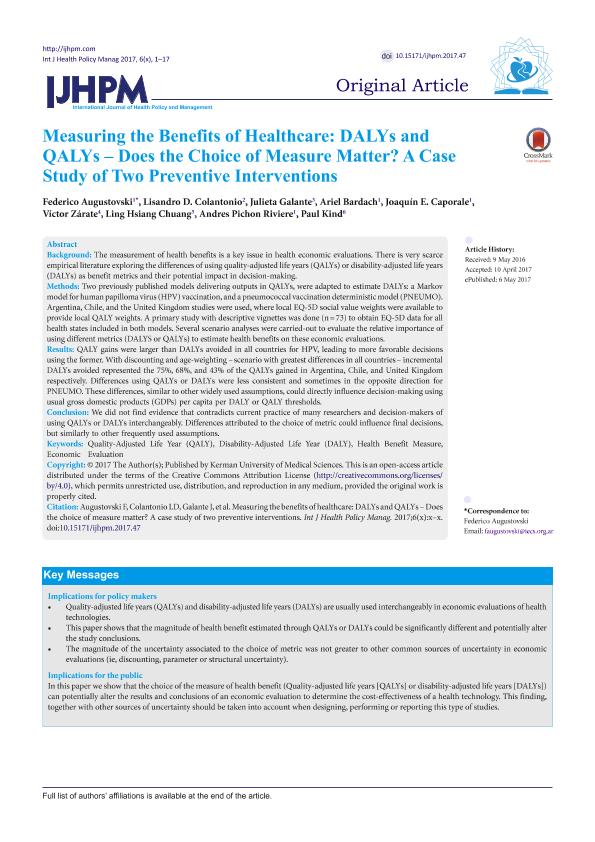Mostrar el registro sencillo del ítem
dc.contributor.author
Augustovski, Federico Ariel

dc.contributor.author
Colantonio, Lisandro Damián

dc.contributor.author
Galante, Julieta
dc.contributor.author
Bardach, Ariel Esteban

dc.contributor.author
Caporale, Joaquín E.
dc.contributor.author
Zárate, Víctor
dc.contributor.author
Chuang, Ling Hsiang
dc.contributor.author
Pichón-Riviere, Andrés

dc.contributor.author
Kind, Paul
dc.date.available
2018-05-10T18:24:49Z
dc.date.issued
2017-01
dc.identifier.citation
Augustovski, Federico Ariel; Colantonio, Lisandro Damián; Galante, Julieta; Bardach, Ariel Esteban; Caporale, Joaquín E.; et al.; Measuring the Benefits of Healthcare: DALYs and QALYs – Does the Choice of Measure Matter? A Case Study of Two Preventive Interventions; Kerman University of Medical Sciences; International Journal of Health Policy and Management; 7; 2; 1-2017; 120-136
dc.identifier.issn
2322-5939
dc.identifier.uri
http://hdl.handle.net/11336/44801
dc.description.abstract
Background
The measurement of health benefits is a key issue in health economic evaluations. There is very scarce empirical literature exploring the differences of using quality-adjusted life years (QALYs) or disability-adjusted life years (DALYs) as benefit metrics and their potential impact in decision-making.
Methods
Two previously published models delivering outputs in QALYs, were adapted to estimate DALYs: a Markov model for human papilloma virus (HPV) vaccination, and a pneumococcal vaccination deterministic model (PNEUMO). Argentina, Chile, and the United Kingdom studies were used, where local EQ-5D social value weights were available to provide local QALY weights. A primary study with descriptive vignettes was done (n = 73) to obtain EQ-5D data for all health states included in both models. Several scenario analyses were carried-out to evaluate the relative importance of using different metrics (DALYS or QALYs) to estimate health benefits on these economic evaluations.
Results
QALY gains were larger than DALYs avoided in all countries for HPV, leading to more favorable decisions using the former. With discounting and age-weighting – scenario with greatest differences in all countries – incremental DALYs avoided represented the 75%, 68%, and 43% of the QALYs gained in Argentina, Chile, and United Kingdom respectively. Differences using QALYs or DALYs were less consistent and sometimes in the opposite direction for PNEUMO. These differences, similar to other widely used assumptions, could directly influence decision-making using usual gross domestic products (GDPs) per capita per DALY or QALY thresholds.
Conclusion
We did not find evidence that contradicts current practice of many researchers and decision-makers of using QALYs or DALYs interchangeably. Differences attributed to the choice of metric could influence final decisions, but similarly to other frequently used assumptions.
dc.format
application/pdf
dc.language.iso
eng
dc.publisher
Kerman University of Medical Sciences
dc.rights
info:eu-repo/semantics/openAccess
dc.rights.uri
https://creativecommons.org/licenses/by/2.5/ar/
dc.subject
Qaly
dc.subject
Daly
dc.subject.classification
Salud Ocupacional

dc.subject.classification
Ciencias de la Salud

dc.subject.classification
CIENCIAS MÉDICAS Y DE LA SALUD

dc.title
Measuring the Benefits of Healthcare: DALYs and QALYs – Does the Choice of Measure Matter? A Case Study of Two Preventive Interventions
dc.type
info:eu-repo/semantics/article
dc.type
info:ar-repo/semantics/artículo
dc.type
info:eu-repo/semantics/publishedVersion
dc.date.updated
2018-03-27T20:00:39Z
dc.journal.volume
7
dc.journal.number
2
dc.journal.pagination
120-136
dc.journal.pais
Irán

dc.description.fil
Fil: Augustovski, Federico Ariel. Consejo Nacional de Investigaciones Científicas y Técnicas. Oficina de Coordinación Administrativa Pque. Centenario. Centro de Investigaciones En Epidemiología y Salud Publica. Instituto de Efectividad Clinica y Sanitaria. Centro de Investigaciones En Epidemiología y Salud Publica.; Argentina
dc.description.fil
Fil: Colantonio, Lisandro Damián. University of Alabama at Birmingahm; Estados Unidos
dc.description.fil
Fil: Galante, Julieta. Cardiff University; Reino Unido
dc.description.fil
Fil: Bardach, Ariel Esteban. Consejo Nacional de Investigaciones Científicas y Técnicas. Oficina de Coordinación Administrativa Pque. Centenario. Centro de Investigaciones En Epidemiología y Salud Publica. Instituto de Efectividad Clinica y Sanitaria. Centro de Investigaciones En Epidemiología y Salud Publica.; Argentina
dc.description.fil
Fil: Caporale, Joaquín E.. Consejo Nacional de Investigaciones Científicas y Técnicas. Oficina de Coordinación Administrativa Pque. Centenario. Centro de Investigaciones En Epidemiología y Salud Publica. Instituto de Efectividad Clinica y Sanitaria. Centro de Investigaciones En Epidemiología y Salud Publica.; Argentina
dc.description.fil
Fil: Zárate, Víctor. Universidad San Sebastian; Chile
dc.description.fil
Fil: Chuang, Ling Hsiang. Pharmerit; Países Bajos
dc.description.fil
Fil: Pichón-Riviere, Andrés. Consejo Nacional de Investigaciones Científicas y Técnicas. Oficina de Coordinación Administrativa Pque. Centenario. Centro de Investigaciones En Epidemiología y Salud Publica. Instituto de Efectividad Clinica y Sanitaria. Centro de Investigaciones En Epidemiología y Salud Publica.; Argentina
dc.description.fil
Fil: Kind, Paul. University of Leeds; Reino Unido
dc.journal.title
International Journal of Health Policy and Management
dc.relation.alternativeid
info:eu-repo/semantics/altIdentifier/url/http://www.ijhpm.com/article_3356_0.html
dc.relation.alternativeid
info:eu-repo/semantics/altIdentifier/doi/http://dx.doi.org/10.15171/IJHPM.2017.47
Archivos asociados
